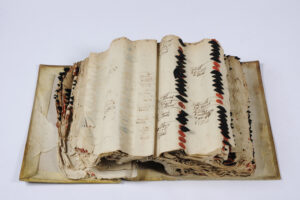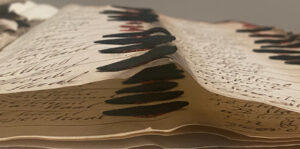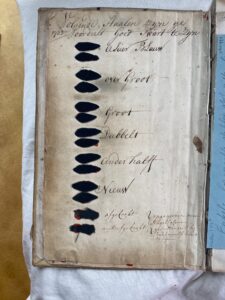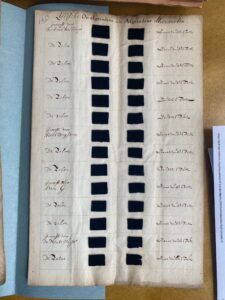CATEGORY
Textiles
START
2024
STATUS
Active
ACRONYM
Black Magic
The project will focus primarily on a unique collection of 33 staalmeestersboeken, which are books filled with hundreds of black-dyed woollen samples, and which are part of the Museum De Lakenhal in Leiden, Netherlands (Figure 1). These books are the result of minutely registered inspections on black broadcloth fabrics produced by the Leiden textile industry between 1695 and 1791, a period coinciding with Leiden’s prominence and subsequent decline as leading centre of global broadcloth production and trade. Leiden was indeed one of the most important early modern European centres of black wool manufacture, importing fine Spanish merino wool and expensive American dyes to make broadcloth meant for export to Southern Europe, Africa or Asia. The books are therefore an invaluable early testimony for the development of advanced standardization practices and quality controls for an international market, and irreplaceable reference records of hundred years of Dutch textile heritage and historical colour knowledge. This raises this project’s major research question: How did Leiden’s role as an international textile centre and its place in the globalisation of trade and colonial interactions in the 18th century shaped the institutionalization of colour quality controls?
Although the books have remained largely inaccessible due to their fragile condition, a recently established advanced digitisation method has come to allow their much needed study. This project aims to unlock their immense potential to establish how colour quality controls institutionalised at Lakenhal came to shape Leiden’s role as an international textile centre and its place in the globalisation of trade in the 18th century. In this context, it aims to determine the ingredients and methods of production used in the staalmeestersboeken samples; how quality control and colour standardization practices developed and changed; and to what extent Leiden’s regulations on black wool production corresponded to actual practices performed by local industries. In addition, it aims to draw conclusions on the current condition of the wool samples and their future preservation in the books.

Lakenhal Sample Book folio with two rows of black wool samples attached with red sealing wax on the pages, inv. no. 1312.01 (Photo credits: Museum De Lakenhal).

Row of black wool samples showing different tonalities of black and nap thickness, and the quality grades registered on the left side, inv. no. 1312.01 (Photo credits: Jenny Boulboullé).


Kwaliteitsstalen, archival nr. 0510, Erfgoed Leiden en Omstreken: left – quality grades with wool standards; right – quality grades with wool standards before (onafgezoden stalen) and after (afgezoden stalen) inspection (Photo credits: Jenny Boulboullé).